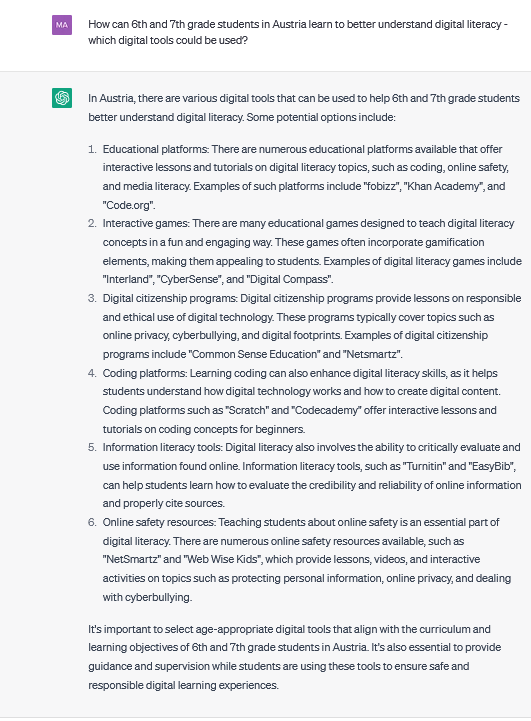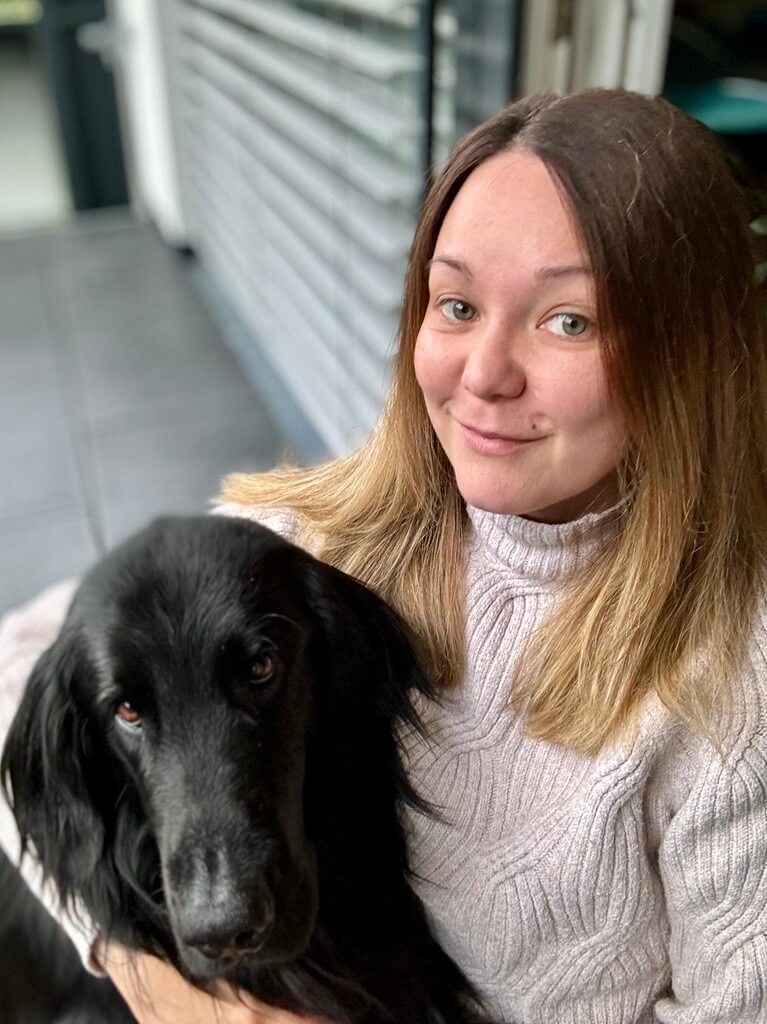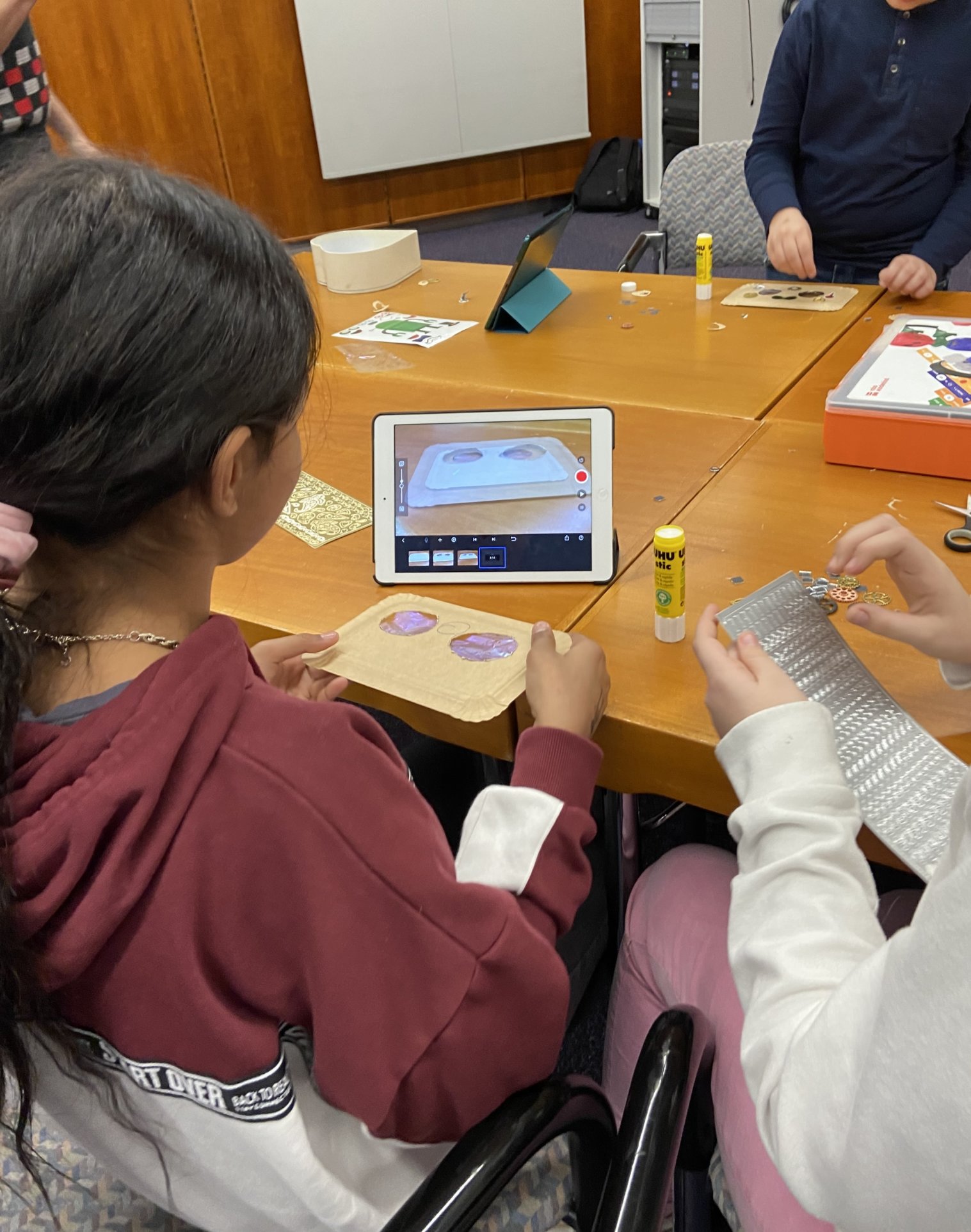ChatGPT – here to stay: Part I
What is it exactly and why is it so relevant?
Chatbots that help us code in a natural way or assist in designing a lesson on digital media literacy for seventh grade – the sudden arrival of widely usable Artificial Intelligence (AI) has turned our world upside down. From a practical perspective, we are also facing many socially relevant questions. For example, whether and in what way tools like ChatGPT from OpenAI will find a place in the world of education?
The head-in-the-sand tactic is unlikely to work for long – our conversation partners agree on this. That’s why they have early on engaged with ChatGPT and are using it as an “artificial assistant” in the classroom. (More information about its use in education will be available soon!) Our conversation partners are:
- Michael Lutz, EdTech Coach and teacher of grades 1-3 in the Canton of Zurich
- Alicia Bankhofer, teacher at a school in Vienna, teaching Digital Literacy and English in secondary level 1
- Martin Wieser, Educator and EdGame designer
They see many exciting new opportunities for teachers and learners, but also some risks. And indeed, leading experts seem to disagree on the consequences and future developments of this technology. However, one thing echoes unanimously throughout the world: this new type of smart programs has come to stay.
The Artificial Assistant
ChatGPT belongs to the digital family of “Generative Artificial Intelligence”. These are content-generating technologies, which also include image and animation tools like DALL-E, Midjourney, or NightCafe. ChatGPT is based on the approach of machine learning and “learns” from information on the internet. As a smart language model, it works specifically by analyzing patterns and providing detailed responses to individual user inputs. The text is then output as a chat response in natural language based on natural language processing. This makes writing simple texts or working on formulas – whether for a specific Excel table or an HTML code for a website – easier. This makes the bot an artificial assistant that can be a helpful tool in many industries.
Just give it a try
Although the currently freely accessible version of ChatGPT may seem simple at first glance, there are some pitfalls to getting the best features out of the tool. The magic word is “Prompt Engineering”. It may sound complicated, but it’s not. It’s important to understand how commands (prompts) work best. A good tip is to think carefully beforehand about what the end result should be and then formulate a task to the bot as specifically as possible. If a teacher only writes “Examples of Austrian mountain landscapes”, the tool will generate very generic content. But if they write “10 examples of the flora and fauna of Grossglockner in Austria with 5 multiple-choice questions for 5th grade learners”, more specific content will be generated. It could also be helpful to imagine that the digital assistant may need more detailed instructions. After all, it’s still in the training phase, so precise instructions are often needed. The first question or instruction doesn’t have to be perfect, it can be further formulated after the first “answer” from ChatGPT, just like in a conversation.

Better not look away
As with other (educational) programs, it ultimately depends on how we use them and how we critically engage with the generated answers. Not everything that ChatGPT provides is necessarily correct.
“We don’t just take the first two search results on Google or believe every word written on Wikipedia.”
That’s what Alicia Bankhofer, who teaches digital literacy and English in secondary level 1 at a school in Vienna, says. Developers have described these issues as “hallucinations” – when the technology generates fact-free, invented content. So it is possible that dates, places, or even entire events may not be accurate. Therefore, it is recommended to always verify the correctness of the answers.
Aside from these risks, there is also a real hope for more educational equality in the field of education through easy access to vast amounts of information. And above all, one thing should not be forgotten:
“The kids are already using it themselves, so what would be the point of banning it or ignoring it as teachers? Many parents are simply overwhelmed with the technology and the multitude of topics it brings with it. It is up to us teachers to teach the children a safe and ethical approach. Who else is going to do it?”
That’s what Michael Lutz says. In Part II, we looked at how educators are currently incorporating ChatGPT into their teaching in a responsible and innovative way.
(Editor’s note: No, this article was not written with ChatGPT, but translated from German to English 😉 )
FAQ ChatGPT
What is ChatGPT and what is ChatGPT not?
Is ChatGPT intelligent or not? That depends on the perspective and poses the philosophical question – what is intelligence? Currently, we refer to ChatGPT as artificial intelligence, in the sense of a multidimensional technology. What it is not, is a “General AI” as we know from science fiction stories, i.e., a true superintelligence that acts and thinks independently. That doesn’t exist (yet).
What can you do with it?
ChatGPT is intended to be a tool for making work easier and providing intuitive answers to user commands, more so than other search engines or online encyclopedias. There are countless possibilities for using ChatGPT in work or educational settings and for learning with it.
How can it be best used in the classroom?
We will discuss this in the upcoming second part of our ChatGPT series!
Is ChatGPT child-safe?
No. That’s why solutions are now emerging that develop their own learning programs, such as the educational platform fobizz (more on that in Part II), based on ChatGPT. Here, teachers can create their own rooms on specific topics where the chatbot is child-friendly.
Is this here to stay?
No one can predict the future, but most experts agree that AI assistants like ChatGPT, Dall-E, or Midjourney are just the beginning. There are already many other offerings alongside these market leaders, and it is likely that these tools will soon be used as commonly as search engines or navigation systems.
More articles
The following articles might also interest you.

This is the EdTech Austria Team: Project Manager Magdalena Gärtner
25. July 2024

Keep calm and keep learning: The EdTech Future Journey 2024
23. April 2024

This is the EdTech Austria team: Project Leader Jools Turrell
15. February 2024

ISTE Seal: The Seal of Approval for Digital Learning Tools
20. December 2023

Programming made easy: Coding Day 2023
27. November 2023
